纺织英语教案
- 格式:doc
- 大小:17.66 MB
- 文档页数:62
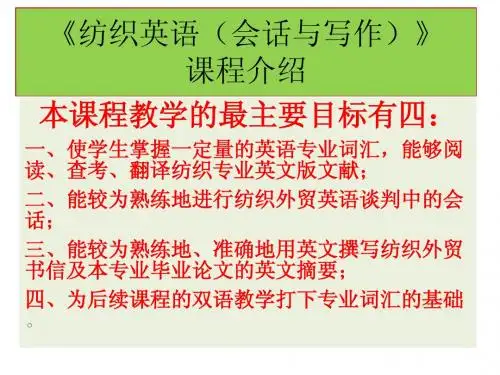
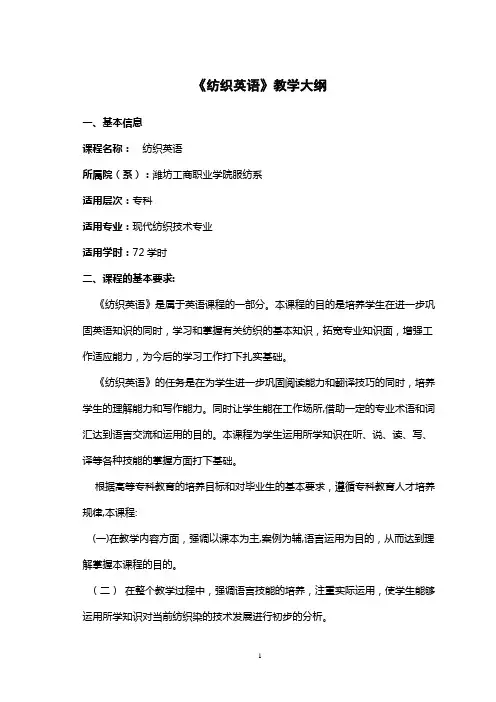
《纺织英语》教学大纲一、基本信息课程名称:纺织英语所属院(系):潍坊工商职业学院服纺系适用层次:专科适用专业:现代纺织技术专业适用学时:72学时二、课程的基本要求:《纺织英语》是属于英语课程的一部分。
本课程的目的是培养学生在进一步巩固英语知识的同时,学习和掌握有关纺织的基本知识,拓宽专业知识面,增强工作适应能力,为今后的学习工作打下扎实基础。
《纺织英语》的任务是在为学生进一步巩固阅读能力和翻译技巧的同时,培养学生的理解能力和写作能力。
同时让学生能在工作场所,借助一定的专业术语和词汇达到语言交流和运用的目的。
本课程为学生运用所学知识在听、说、读、写、译等各种技能的掌握方面打下基础。
根据高等专科教育的培养目标和对毕业生的基本要求,遵循专科教育人才培养规律,本课程:(一)在教学内容方面,强调以课本为主,案例为辅,语言运用为目的,从而达到理解掌握本课程的目的。
(二)在整个教学过程中,强调语言技能的培养,注重实际运用,使学生能够运用所学知识对当前纺织染的技术发展进行初步的分析。
三、教学内容:(一) 纺织纤维。
(二)纱线种类(三)染色工艺及设备(四)纺织品整理四、教学的基本要求通过本课程的教学应使学生达到以下基本要求:(一)掌握纺织的重要概念和基础理论。
(二)掌握重要的纺织词汇和术语(三)语言的交流和运用方面:学生能在工作场所,借助一定的专业术语和词汇与外籍人士进行简单交流,把专业知识能用英语交流和运用。
(四)语法: 学生在原有语法基础上,进一步熟悉英文原材料中语法的运用。
能够运用所学语法知识解决阅读和翻译中常见的问题。
(五)阅读能力:掌握基本阅读技能,并能运用所学的词汇和语法知识,正确理解英文原材料内容。
五、学时分配本课程共72课时,每周4课时. 以下是课时的基本分配六、说明(一)纺织是一个非常广泛的概念,可以分为很多的专业知识科目。
本课程是以英语语言教授的基础课程,重点在于与纺织纺织相关的知识的理解;同时巩固学生英语知识的运用,了解纺织英语基本内容的专业基础课程。
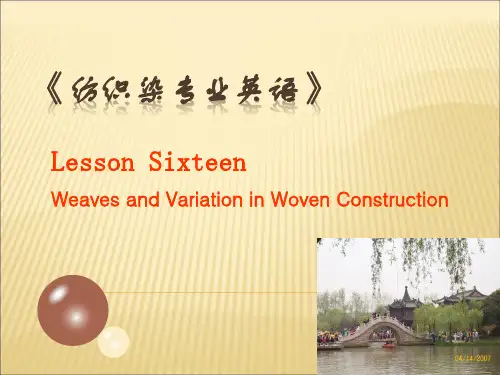
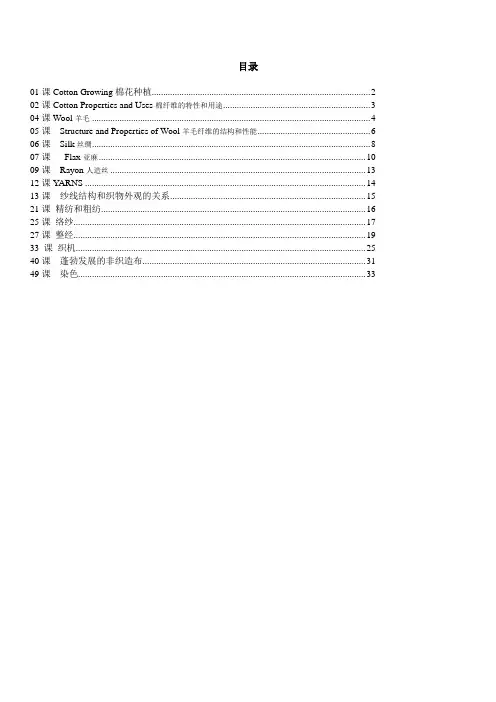
目录01课Cotton Growing棉花种植 (1)02课Cotton Properties and Uses棉纤维的特性和用途 (2)04课Wool羊毛 (3)05课Structure and Properties of Wool羊毛纤维的结构和性能 (5)06课Silk丝绸 (7)07课Flax亚麻 (9)09课Rayon人造丝 (12)12课YARNS (13)13课纱线结构和织物外观的关系 (14)21课精纺和粗纺 (15)25课络纱 (16)27课整经 (18)33 课织机 (24)40课蓬勃发展的非织造布 (30)49课染色 (32)第一课Cotton Growing棉花种植Cotton is the world's most widely used fiber. Its popularity stems from both its relative ease of production and its applicability to a wide variety of textile products. The price of cotton yarn, however, is strongly dependent upon the cost of labor, so that in the industrialized nations, where labor is expensive, cotton yarns may be relatively high priced.棉花是世界上使用最广泛的纤维。
它的流行源于它的生产及其在纺织产品广泛适用性相对容易。
棉纱价格,然而,强烈地依赖于劳动力成本,因此,在工业化的国家,那里的劳动力昂贵,棉纱可能相对较高的价格。
Until relatively recent times, however, cotton was not as widely used as wool and linen. This was because it was easier to spin wool or flax into yam because of their greater length. In addition, cotton fibers have to be separated from the seeds to which they cling. This procedure was very tedious and time-consuming when done by hand. Early machinery could be used on only the longest staple cotton. So labor costs tended to be very high.直到最近,然而,棉花是没有广泛用作羊毛和亚麻布。
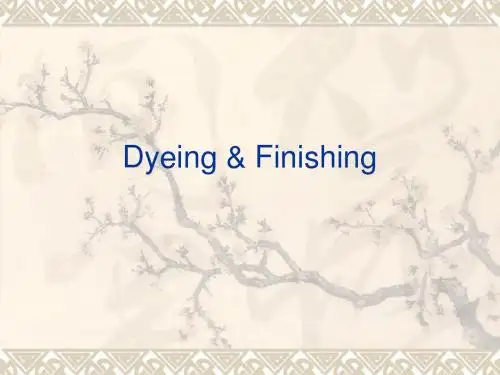

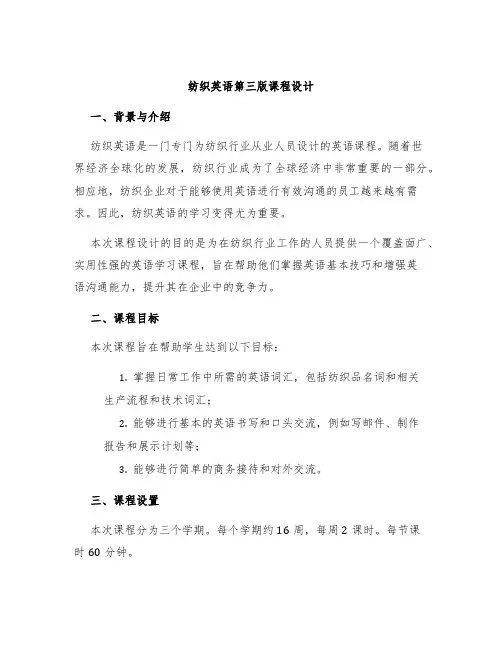
纺织英语第三版课程设计一、背景与介绍纺织英语是一门专门为纺织行业从业人员设计的英语课程。
随着世界经济全球化的发展,纺织行业成为了全球经济中非常重要的一部分。
相应地,纺织企业对于能够使用英语进行有效沟通的员工越来越有需求。
因此,纺织英语的学习变得尤为重要。
本次课程设计的目的是为在纺织行业工作的人员提供一个覆盖面广、实用性强的英语学习课程,旨在帮助他们掌握英语基本技巧和增强英语沟通能力,提升其在企业中的竞争力。
二、课程目标本次课程旨在帮助学生达到以下目标:1.掌握日常工作中所需的英语词汇,包括纺织品名词和相关生产流程和技术词汇;2.能够进行基本的英语书写和口头交流,例如写邮件、制作报告和展示计划等;3.能够进行简单的商务接待和对外交流。
三、课程设置本次课程分为三个学期。
每个学期约16周,每周2课时。
每节课时60分钟。
第一学期1.纺织产品介绍–手感测评介绍–纺织面料成分介绍–纺织品种类介绍2.生产流程–着色工艺–纺纱工艺–成品缩水率测试3.设计拓展–织造图案设计–着色技术设计–染整设计4.面料检验–面料外观检验–织物穿透检验–黏胶检验第二学期1.销售技巧–产品定位–销售时的问答技巧–应对不同客户类型的技巧2.市场分析–竞争力分析–买方市场分析–公司与市场之间的策略关系分析3.创新技能–产品开发技能–实施销售战略–管理品质4.管理组织–组织规划–工厂生产线调整与改进–员工培训第三学期1.企业文化–企业文化的理解与解释–企业文化营销的价值–品牌营销之必然步骤2.高级会议–按时间安排会议–记录会议并制作纪要–开展会议后的跟进工作3.调整管理策略–应对夹在市场竞争中的企业–分配人力资源–改期管理策略4.回顾部分–良好的企业文化–团队协作的重要性–最终考核四、教学方法本次培训化的教学方式:1.外籍专家授课:–来自英美纺织业的专家,能够将学生的英语翻译并进行解释,提供更为丰富且实用的纺织英语知识;–保证后续课程的讲解和教学的完善性。
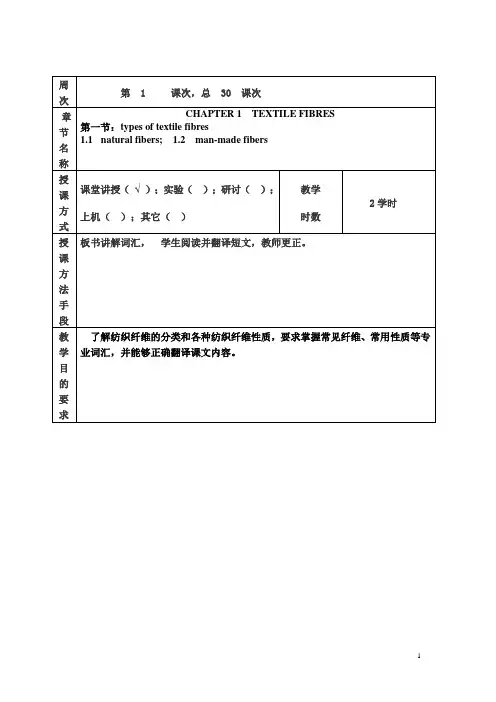
注:教案按课次填写,每课次均应填写一份,各课次构成完整的教案。
附:教案内页参考格式
注:教案按课次填写,每课次均应填写一份,各课次构成完整的教案。
注:教案按课次填写,每课次均应填写一份,各课次构成完整的教案。
注:教案按课次填写,每课次均应填写一份,各课次构成完整的教案。
注:教案按课次填写,每课次均应填写一份,各课次构成完整的教案。
注:教案按课次填写,每课次均应填写一份,各课次构成完整的教案。
1王善元,于修业.《new textile yarns》东华大学出版社,2007.4 注:教案按课次填写,每课次均应填写一份,各课次构成完整的教案。
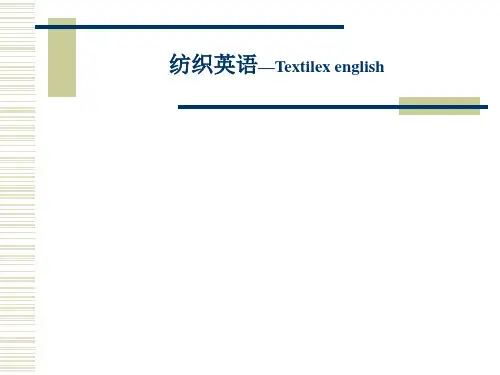
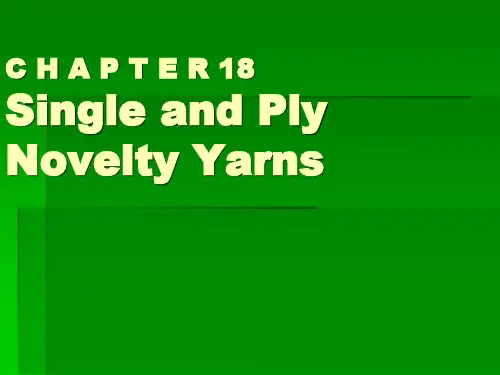
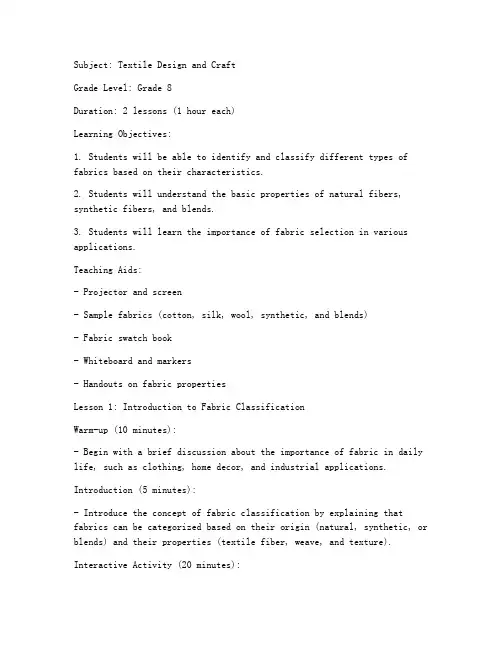
Subject: Textile Design and CraftGrade Level: Grade 8Duration: 2 lessons (1 hour each)Learning Objectives:1. Students will be able to identify and classify different types of fabrics based on their characteristics.2. Students will understand the basic properties of natural fibers, synthetic fibers, and blends.3. Students will learn the importance of fabric selection in various applications.Teaching Aids:- Projector and screen- Sample fabrics (cotton, silk, wool, synthetic, and blends)- Fabric swatch book- Whiteboard and markers- Handouts on fabric propertiesLesson 1: Introduction to Fabric ClassificationWarm-up (10 minutes):- Begin with a brief discussion about the importance of fabric in daily life, such as clothing, home decor, and industrial applications.Introduction (5 minutes):- Introduce the concept of fabric classification by explaining that fabrics can be categorized based on their origin (natural, synthetic, or blends) and their properties (textile fiber, weave, and texture).Interactive Activity (20 minutes):- Hand out fabric swatches and a fabric swatch book to students.- Ask students to examine the fabrics and identify their characteristics such as texture, weave, and color.- In groups, have students classify the fabrics into natural, synthetic, and blend categories.Group Discussion (10 minutes):- Discuss the differences between natural and synthetic fibers.- Explore the advantages and disadvantages of each type of fabric.Homework Assignment:- Ask students to research and bring in a natural fiber, a synthetic fiber, and a blend fabric to class for the next lesson.Lesson 2: Exploring Fabric Properties and ApplicationsReview (5 minutes):- Review the fabric classifications from the previous lesson.Demonstration (10 minutes):- Demonstrate how to identify different fabric properties such as elasticity, durability, and water absorption using the fabrics broughtin by students.Interactive Activity (20 minutes):- Have students create a collage or poster showing the different fabrics and their applications (e.g., cotton for clothing, silk for bedding).Group Project (15 minutes):- In groups, students will create a small fabric sample using different techniques such as weaving, knitting, or felting.- Each group will research and present the properties and applications of their fabric sample.Conclusion (5 minutes):- Summarize the key points of the lesson.- Encourage students to think about the importance of fabric selection in their own lives.Assessment:- Observe student participation during the interactive activities and group discussions.- Evaluate the quality of the fabric samples and presentations created by the students.- Check the homework assignment to assess students' understanding of fabric properties and applications.Materials Needed:- Fabric swatches- Fabric swatch book- Whiteboard and markers- Handouts on fabric properties- Scissors, needles, thread, and other crafting materials for the group projectNote: This教案 template can be adapted to different grade levels and subject areas by adjusting the complexity of the activities and the depth of the content.。
布料分类教案英语初中Objective:At the end of this lesson, students will be able to understand the different types of fabrics and classify them based on their characteristics.Materials:- Various fabrics (cotton, silk, wool, synthetic, etc.)- Chart paper or whiteboard- Markers or chalkProcedure:1. Introduction (5 minutes)- Begin the lesson by introducing the concept of fabrics and their importance in our daily lives.- Discuss the different types of fabrics and their uses. For example, cotton is commonly used for clothing, silk for formal wear, and wool for warmth.2. Exploring Fabrics (10 minutes)- Hand out a sample of each fabric to the students and allow them to touch and feel the fabrics.- Ask students to describe the feel of each fabric (e.g., smooth, rough, soft, scratchy) and make observations about their characteristics (e.g., transparency, elasticity, absorbency).3. Classifying Fabrics (15 minutes)- Explain to students that they will now classify the fabrics based on their characteristics. - Give each student a piece of chart paper or a whiteboard and provide them with markers or chalk.- Instruct students to write the name of each fabric at the top of their chart paper or whiteboard.- Below each fabric name, ask students to list the characteristics that distinguish it from the others.4. Grouping Fabrics (10 minutes)- Once students have completed their lists, ask them to work in groups to compare their findings and discuss how to group the fabrics based on their characteristics.- Encourage students to use vocabulary such as "natural" and "synthetic" to describe the fabrics.- Allow each group to present their classification to the class and discuss any differences in opinions.5. Conclusion (5 minutes)- Summarize the different types of fabrics and their characteristics.- Discuss the importance of understanding fabric classification in everyday life, such as when shopping for clothing or understanding the care instructions for different fabrics. Assessment:-Observe students' participation during the exploration and classification activities.-Assess students' understanding of fabric characteristics through their lists and group discussions.-Encourage students to ask questions and provide feedback during the lesson.Note: This lesson can be adapted to different age levels and can be extended by exploring the history of fabrics and their impact on society.。
制作衣服英语课程设计一、课程目标知识目标:1. 学生能够掌握与衣服制作相关的英语词汇,如fabric, pattern, stitch等;2. 学生能够运用英语描述衣服制作的步骤和工艺;3. 学生了解不同文化背景下的服装特点及相应的英语表达。
技能目标:1. 学生能够运用英语进行衣服制作过程中的交流与讨论;2. 学生通过小组合作,运用英语完成衣服制作项目的展示;3. 学生能够运用英语撰写简单的衣服制作说明。
情感态度价值观目标:1. 培养学生对服装制作的兴趣,激发他们探索服装文化的热情;2. 增强学生的团队合作意识,培养他们在合作中尊重他人、倾听他人意见的良好习惯;3. 培养学生关注环保,提倡可持续发展的服装制作理念。
课程性质:本课程为英语学科拓展课程,以衣服制作为主题,结合英语语言学习,提高学生的英语实际应用能力。
学生特点:六年级学生具有一定的英语基础,对新鲜事物充满好奇,善于合作,有较强的表现欲望。
教学要求:教师应注重培养学生的英语实际应用能力,将语言学习与实际操作相结合,提高学生的综合素质。
在教学过程中,关注学生的个体差异,鼓励学生积极参与,充分展示自己的才华。
同时,注重培养学生的情感态度价值观,使他们在学习过程中形成正确的价值观。
二、教学内容本课程依据课程目标,结合教材内容,组织以下教学大纲:1. 介绍衣服制作基本概念及英语词汇(第一课时)- 词汇学习:fabric, pattern, stitch, sew, hem等;- 了解衣服制作的基本步骤和工艺。
2. 衣服制作步骤及英语表达(第二课时)- 学习衣服制作的具体步骤,如测量、裁剪、缝合、熨烫等;- 运用英语描述各步骤,练习相关句型。
3. 不同文化背景下的服装特点及英语表达(第三课时)- 了解世界各地的服装特点,如中国的旗袍、印度的莎丽等;- 学习相关英语词汇和表达,进行文化交流。
4. 小组合作项目:衣服制作展示(第四至六课时)- 学生分组,制定衣服制作计划;- 运用英语进行讨论、交流,完成衣服制作;- 撰写英语展示稿,进行成果展示。
The Teaching Plan for the course of “English for Textile Business”纺织商务英语教案设计Project One Reception Of A Delegation From The US综合项目一接待来美代表团教学步骤及内容Teaching Procedures & detailsI.Assignment last time. (15 Minutes)Field work:Work in groups of up to six. Choose two important textile or garmement companies in China and in the US and do a research on these two companies. Prepare for a three-minutes presentation to share the information to the whole class. (The presentation should be facilitated by ppt)II. Discussion questions ( 15 minutes)《Lead-in questionsBy answering some basic questions you will identify things that will help you when working as a receptionist of a delegation. Some of the key questions to ask are:1.How do you prepare for the reception2.What makes a good receptionist of a delegationIII. Follow-up of analyzing and evaluating of the students’work assigned last class about introductions of the two companies. ( 10 minutes)These introductions should mainly include line of business, production, and sales of products of the companies.Tasks are presented, including new knowledge and techniques ( 30 minutes)an itinerary-accommodation on the phone ( Holiday Inn)3. Receive guests upon arrivalguests at a restaurant ( welcome speech)a tour of the factorya business negotiationDialoguesHere are some key expressions often used at reception activities.’d like to book some accommodation with your hotel.—you got any single/double rooms for tonight3. Welcome to Changzhou. Please allow me to introduce myself. My name is Hong Jian. I’m deputy managing director of the company.was your flight Was it comfortablehope you enjoy your stay in this city. We’ll do everything we can do to accommodate you and make you comfortable.6. Our managing director Mr. Li will host a reception banquet in your honor tonight, and we would like you to come to the dinner this evening to meet our managingis the specialty of the restaurant8. What would you recommend’s to your success/health!’s a local speciality.tour will take about an hour and a half. We ought to be back here by 3:00.new production line has been very successful. We've expanded the factory twice this year already.、's the most up-to-date in the industry.'ve increased our efficiency by 20% through automation.you tell me the cost of production per unitIV.Practice for consolidation by role-plays (10 minutes)Work in groups. The students practise the activities presented above. The teacher just works around and gives nececcary help.V. Assignment (10 minutes)Field work:Work in groups of up to six. Collect information and materials from the Internet. Prepare for a presentation to introduce how to attend an exhibition. (The presentation should be facilitated by ppt)。
注:教案按课次填写,每课次均应填写一份,各课次构成完整的教案。
附:教案内页参考格式
注:教案按课次填写,每课次均应填写一份,各课次构成完整的教案。
注:教案按课次填写,每课次均应填写一份,各课次构成完整的教案。
注:教案按课次填写,每课次均应填写一份,各课次构成完整的教案。
注:教案按课次填写,每课次均应填写一份,各课次构成完整的教案。
注:教案按课次填写,每课次均应填写一份,各课次构成完整的教案。
1王善元,于修业.《new textile yarns》东华大学出版社,2007.4 注:教案按课次填写,每课次均应填写一份,各课次构成完整的教案。